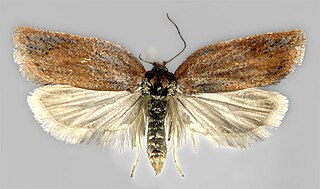- Tortrix cristana [Denis & Schiffermüller], 1775
- Peronea cristana f. albicapitana Sheldon, 1930
- Teras albicostana Sand, 1879
- Peronea albipunctana Stephens, 1829
- Peronea (Lopas) albipunctana Stephens, 1834
- Peronea alboflammana Curtis, 1834
- Peronea alboflavana Curtis, 1834
- Peronea cristana ab. albonigrana Clark, 1901
- Peronea cristana ab. alboruficostana Clark, 1901
- Acleris cristana f. albosericana Fairclough, 1981
- Peronea albovittanaStephens, 1829
- Peronea (Lopas) albovittana Stephens, 1834
- Acleris cristana f. alisana Fairclough, 1981
- Peronea cristana f. apiciana Sheldon, 1930
- Acalla cristana ab. aquilina Larsen, 1927
- Peronea cristana ab. atrana Clark, 1901
- Peronea cristana ab. attaliana Clark, 1901
- Acleris azumina Yasuda & Kawabe, 1980
- Peronea bentleyana Curtis, 1834
- Peronea brunneana Stephens, 1829
- Peronea (Lopas) brunneana Stephens, 1834
- Peronea capucina Capucina, 1842
- Peronea chantana Curtis, 1834
- Peronea cristana ab. charlottana Clark, 1901
- Peronea cristana ab. clarkiana Webb, 1910
- Peronea consimilana Stephens, 1829
- Peronea (Lopas) consimilana Stephens, 1834
- Phalaena cristalana Donovan, [1794]
- Peronea capucina var. curtisana Desvignes, 1845
- Pyralis desfontainana Fabricius, 1794
- Acleris cristana f. dualana Fairclough, 1981
- Pyralis ephippiana Fabricius, 1798
- Peronea cristana ab. flammeana Webb, 1911
- Peronea flavana Capucina, 1842
- Peronea cristana ab. flavana Sheldon, 1921
- Peronea cristana ab. flavostriana Webb, 1911
- Acleris cristana f. fordana Fairclough, 1981
- Peronea cristana ab. fulvana Sheldon, 1921
- Peronea fulvocristana Stephens, 1829
- Peronea (Lopas) fulvocristana Stephens, 1834
- Peronea cristana ab. fulvopunctana Sheldon, 1921
- Acleris cristana f. fulvopurdeyana Fairclough, 1981
- Acleris cristana f. fulvosericana Fairclough, 1981
- Peronea striana var. fulvostriana Desvignes, 1845
- Peronea fulvovittana Stephens, 1829
- Peronea (Lopas) fulvovittana Stephens, 1834
- Peronea cristana ab. fuscana Clark, 1901
- Teras gibbosana Treitschke, 1835
- Peronea cristana ab. gumpiana Clark, 1901
- Peronea gumpinana Capucina, 1842
- Acleris cristana f. inornana Fairclough, 1981
- Peronea insulana Curtis, 1834
- Peronea cristana ab. intermediana Clark, 1901
- Acleris cristana f. janetana Fairclough, 1993
- Peronea jansoniana Webb, 1910
- Peronea cristana ab. larseni Strand, 1918
- Peronea lefebvriana Duponchel, in Godart, 1835
- Peronea lichenana Curtis, 1834
- Acleris cristana f. manleyana Fairclough, 1981
- Peronea cristana ab. masoniana Clark, 1901
- Peronea cristana ab. merlana Clark, 1901
- Peronea cristana ab. nigrana Clark, 1901
- Acleris cristana f. nigrocapitana Fairclough, 1981
- Peronea cristana ab. nigrocostana Clark, 1901
- Peronea cristana ab. nigrocristana Clark, 1901
- Acleris cristana f. nigrofulvana Fairclough, 1981
- Peronea cristana ab. nigropunctana Clark, 1901
- Acleris cristana f. nigropurdeyana Fairclough, 1993
- Peronea cristana ab. nigroruficostana Webb, 1910
- Acleris cristana f. nigrosubcristalana Fairclough, 1981
- Acleris cristana f. nigrosubpurdeyana Fairclough, 1993
- Peronea cristana ab. nigrosubvittana Clark, 1901
- Acleris cristana f. obscurana Fairclough, 1981
- Acleris cristana f. ochreafulvana Fairclough, 1981
- Peronea cristana ab. ochreana Sheldon, 1918
- Peronea cristana ab. ochreapunctana Clark, 1901
- Acleris cristana f. palistriana Fairclough, 1981
- Acleris cristana f. parvana Fairclough, 1993
- Peronea cristana ab. procapucina Huggins, 1949
- Peronea cristana ab. prochantana Clark, 1901
- Peronea cristana ab. procristalana Webb, 1911
- Pyralis profanana Fabricius, 1794
- Acleris cristana f. proinsulana Fairclough, 1981
- Acleris cristana f. prosequana Fairclough, 1993
- Peronea cristana ab. prostriana Clark, 1901
- Acleris cristana f. prosubchantana Fairclough, 1981
- Peronea profana var. provittana Desvignes, 1845
- Peronea cristana ab. proxanthovittana Clark, 1901
- Peronea cristana ab. punctana Clark, 1901
- Peronea cristana ab. purdeyana Webb, 1910
- Pyralis rossiana Fabricius, 1794
- Peronea ruficostana Curtis, 1834
- Peronea cristana ab. ruficristana Webb, 1910
- Peronea cristana ab. rufinigrana Clark, 1901
- Peronea semiustana var. semistriana Desvignes, 1845
- Peronea semiustana Curtis, 1834
- Peronea cristana ab. sepiana Sheldon, 1917
- Peronea sequana Curtis, 1834
- Tortrix sericana Hubner, [1796-1799]
- Peronea cristana ab. sheldoniana Huggins, 1949
- Peronea cristana ab. southiana Sheldon, 1921
- Tortrix spadiceana Haworth, [1811]
- Peronea (Lopas) spadiceana Stephens, 1834
- Tortrix striana Haworth, [1811]
- Peronea cristana ab. subalboflammana Clark, 1901
- Peronea capucina var. subcapucina Desvignes, 1845
- Peronea cristana ab. subchantana Clark, 1901
- Peronea subcristalana Curtis, 1834
- Peronea cristana ab. subfulvovittana Clark, 1901
- Peronea cristana ab. subnigrana Image, 1917
- Acleris cristana f. subochreanigrana Fairclough, 1981
- Peronea substriana Stephens, 1829
- Peronea (Lopas) substriana Stephens, 1834
- Peronea cristana ab. subunicolorana Clark, 1901
- Acleris cristana f. subxanthovittana Fairclough, 1981
- Peronea desfontainana var. tolana Desvignes, 1845
- Peronea cristana ab. transversana Clark, 1901
- Peronea cristana ab. ulotana Clark, 1901
- Peronea unicolorana Desvignes, 1845
- Peronea cristana ab. ustulana Sheldon, 1921
- Peronea cristana ab. vaughaniana Webb, 1911
- Peronea vittana Stephens, 1829
- Peronea (Lopas) vittana Stephens, 1834
- Peronea cristana ab. webbiana Sheldon, 1921
- Peronea xanthovittana var. xanthovittana Desvignes, 1845
|





















